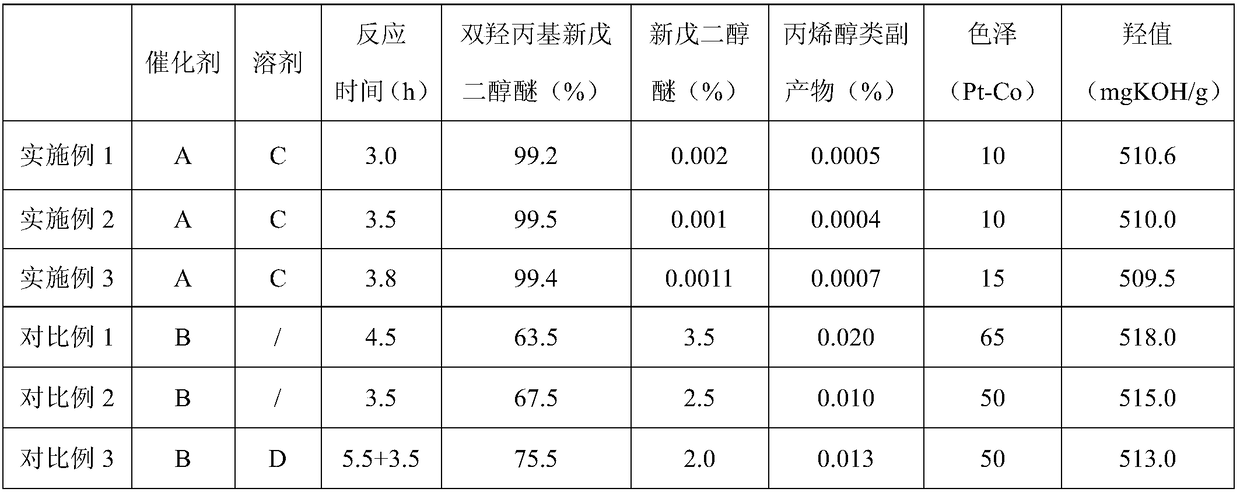A kind of preparation method of dihydroxypropyl neopentyl glycol ether
A technology of bishydroxypropyl neopentyl glycol ether and neopentyl glycol, which is applied in the field of organic compound synthesis, can solve the problems of lowering reaction temperature and product color, complicated production process and long route, prolonging reaction time, etc., and achieves product distribution. Reasonable, light product color, high reactivity effect
- Summary
- Abstract
- Description
- Claims
- Application Information
AI Technical Summary
Problems solved by technology
Method used
Image
Examples
Embodiment 1
[0027] Add 416g of neopentyl glycol, 1.0g of tris(4-methoxyphenyl) phosphine, and 208g of solvent bishydroxypropyl neopentyl glycol ether into the reaction kettle, vacuum with a vacuum pump, and use N 2 Replace the air in the reactor. After three replacements, at the vacuum degree ≥ -0.096MPa, turn off the vacuum and start heating to 95℃. After the material has no obvious solid materials, continue to add 470g of propylene oxide and control the reaction temperature at 95-115℃ , The pressure in the reactor is -0.02~0.4Mpa. After the addition, keep the temperature and continue the reaction until the pressure no longer drops. The addition time of the whole reaction is about 3h. After the reaction is completed, vacuum degassing is used when the temperature is lowered to about 70°C, and the vacuum ≥-0.098MPa is maintained for 10 minutes, and the material is discharged to obtain the finished product. The product was analyzed by liquid chromatography: the content of allyl alcohol by-pro...
Embodiment 2
[0029] Add 416g of neopentyl glycol, 0.6g of tris(4-methoxyphenyl) phosphine, and 350g of solvent bishydroxypropyl neopentyl glycol ether into the reaction kettle. Use a vacuum pump to vacuum and use N 2 Replace the air in the reactor. After three replacements, turn off the vacuum and start heating to 90°C under vacuum ≥-0.096MPa. After there is no obvious solid material, continue to add 480g of propylene oxide, and control the reaction temperature at 95-115°C , The pressure in the reactor is between -0.02~0.4Mpa. After the addition, the temperature is kept and the reaction continues until the pressure no longer drops. The addition time of the whole reaction is about 3.8h. After the reaction is completed, vacuum degassing is used when the temperature is lowered to about 70°C, and the vacuum ≥-0.098MPa is maintained for 10 minutes and then discharged to obtain the finished product. The product was analyzed by liquid chromatography: the content of allyl alcohol by-products was 0.0...
Embodiment 3
[0031] Add 416g of neopentyl glycol, 1.6g of tris(4-methoxyphenyl)phosphine, and 416g of solvent bishydroxypropyl neopentyl glycol ether into the reaction kettle. Use a vacuum pump to vacuum, use N 2 Replace the air in the reactor. After three replacements, at the vacuum degree ≥-0.096MPa, turn off the vacuum and start heating to 90℃. After the material has no obvious solid materials, continue to add 500g of propylene oxide and control the reaction temperature at 95-115℃ , The pressure in the reactor is -0.02~0.35Mpa. After the addition, the temperature is kept and the reaction is continued until the pressure no longer drops. The addition time of the whole reaction is about 3.5h. After the reaction is completed, vacuum degassing is used when the temperature is lowered to about 70°C, and the vacuum ≥-0.098MPa is maintained for 10 minutes and then discharged to obtain the finished product. The product was analyzed by liquid chromatography: the content of allyl alcohol by-products ...
PUM
| Property | Measurement | Unit |
|---|---|---|
| hydroxyl value | aaaaa | aaaaa |
| color | aaaaa | aaaaa |
Abstract
Description
Claims
Application Information
 Login to View More
Login to View More - R&D
- Intellectual Property
- Life Sciences
- Materials
- Tech Scout
- Unparalleled Data Quality
- Higher Quality Content
- 60% Fewer Hallucinations
Browse by: Latest US Patents, China's latest patents, Technical Efficacy Thesaurus, Application Domain, Technology Topic, Popular Technical Reports.
© 2025 PatSnap. All rights reserved.Legal|Privacy policy|Modern Slavery Act Transparency Statement|Sitemap|About US| Contact US: help@patsnap.com


